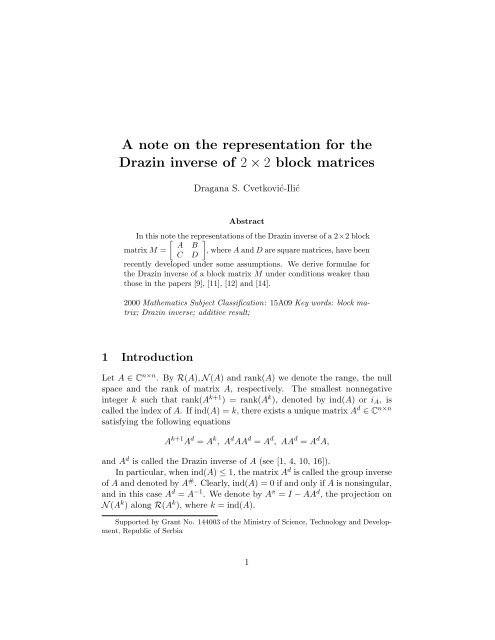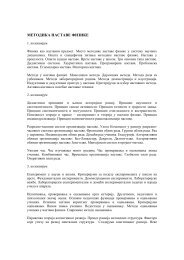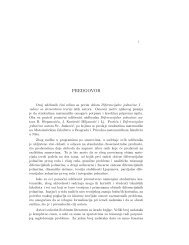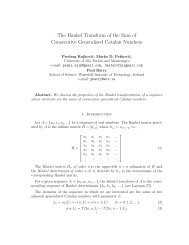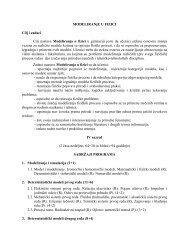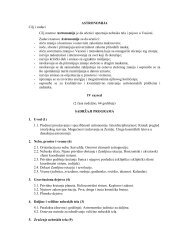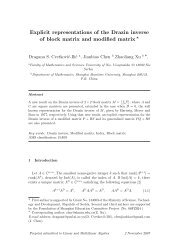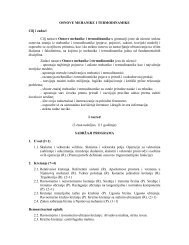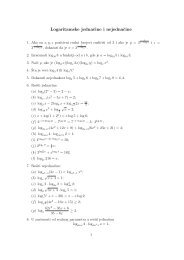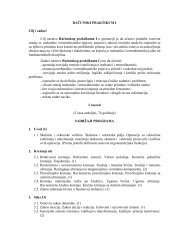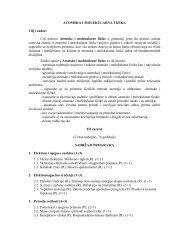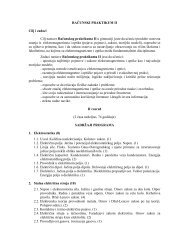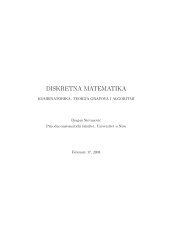A note of the representation of the Drazin inverse of 2x2 block matrix
A note of the representation of the Drazin inverse of 2x2 block matrix
A note of the representation of the Drazin inverse of 2x2 block matrix
You also want an ePaper? Increase the reach of your titles
YUMPU automatically turns print PDFs into web optimized ePapers that Google loves.
A <strong>note</strong> on <strong>the</strong> <strong>representation</strong> for <strong>the</strong><strong>Drazin</strong> <strong>inverse</strong> <strong>of</strong> 2 × 2 <strong>block</strong> matricesDragana S. Cvetković-IlićAbstractIn this <strong>note</strong> [ <strong>the</strong> <strong>representation</strong>s ] <strong>of</strong> <strong>the</strong> <strong>Drazin</strong> <strong>inverse</strong> <strong>of</strong> a 2×2 <strong>block</strong>A B<strong>matrix</strong> M = , where A and D are square matrices, have beenC Drecently developed under some assumptions. We derive formulae for<strong>the</strong> <strong>Drazin</strong> <strong>inverse</strong> <strong>of</strong> a <strong>block</strong> <strong>matrix</strong> M under conditions weaker thanthose in <strong>the</strong> papers [9], [11], [12] and [14].2000 Ma<strong>the</strong>matics Subject Classification: 15A09 Key words: <strong>block</strong> <strong>matrix</strong>;<strong>Drazin</strong> <strong>inverse</strong>; additive result;1 IntroductionLet A ∈ C n×n . By R(A), N (A) and rank(A) we de<strong>note</strong> <strong>the</strong> range, <strong>the</strong> nullspace and <strong>the</strong> rank <strong>of</strong> <strong>matrix</strong> A, respectively. The smallest nonnegativeinteger k such that rank(A k+1 ) = rank(A k ), de<strong>note</strong>d by ind(A) or i A , iscalled <strong>the</strong> index <strong>of</strong> A. If ind(A) = k, <strong>the</strong>re exists a unique <strong>matrix</strong> A d ∈ C n×nsatisfying <strong>the</strong> following equationsA k+1 A d = A k , A d AA d = A d , AA d = A d A,and A d is called <strong>the</strong> <strong>Drazin</strong> <strong>inverse</strong> <strong>of</strong> A (see [1, 4, 10, 16]).In particular, when ind(A) ≤ 1, <strong>the</strong> <strong>matrix</strong> A d is called <strong>the</strong> group <strong>inverse</strong><strong>of</strong> A and de<strong>note</strong>d by A # . Clearly, ind(A) = 0 if and only if A is nonsingular,and in this case A d = A −1 . We de<strong>note</strong> by A π = I − AA d , <strong>the</strong> projection onN (A k ) along R(A k ), where k = ind(A).Supported by Grant No. 144003 <strong>of</strong> <strong>the</strong> Ministry <strong>of</strong> Science, Technology and Development,Republic <strong>of</strong> Serbia1
In this paper, using an additive result for <strong>the</strong> <strong>Drazin</strong> inverese provedin [6],[we derive]formulae for <strong>the</strong> <strong>Drazin</strong> <strong>inverse</strong> <strong>of</strong> a 2 × 2 <strong>block</strong> <strong>matrix</strong>A BM = , under <strong>the</strong> conditions weaker than those in <strong>the</strong> papers [9],C D[11], [12] and [14].2 ResultsFirst, we present an additive result for <strong>the</strong> <strong>Drazin</strong> <strong>inverse</strong> proved in [6],which we will be useful in proving our main result.Theorem 2.1 Let P, Q ∈ C n×n be such that Q dconditions are satisfied= 0 and <strong>the</strong> followingP π Q = Q, P QP π = 0. (3)Then,∞∑(P + Q) d = P d + (P + Q) n Q(P d ) n+2 .n=0In <strong>the</strong> following <strong>the</strong>orem we derive a formula for <strong>the</strong> <strong>Drazin</strong> <strong>inverse</strong> <strong>of</strong><strong>block</strong>-<strong>matrix</strong> M under some ra<strong>the</strong>r cumbersome and complicated conditionsbut <strong>the</strong> <strong>the</strong>orem itself will have a number <strong>of</strong> useful consequences which willinclude much simpler conditions.[ A BTheorem 2.2 Let M =C Dand], where A ∈ C n×n and D ∈ C m×m . IfD π C = C, BCA π = 0, DCA π = 0 (4)i D −1∑(A d ) n+1 BD n C = 0,n=0i∑D −1n=0i∑D −1n=0DC(A d ) n+1 BD n D π = 0,BC(A d ) n+1 BD n D π = 0,(5)3
<strong>the</strong>nM d =[ ] AdX0 D d +∞∑[ A BC Dn=0] n []0 0C(A d ) n+2 ∑ n+2i=1 C(Ad ) i−1 X(D d ) n+2−i , (6)where X = X(A, B, D) is defined by (2).Pro<strong>of</strong>. We rewrite M = P + Q, where P =By Theorem 1.1,P d =[ ] AdX0 D d ,[ A B0 D]and Q =[ 0 0C 0where X = X(A, B, D) is defined by (2). Now, we have that <strong>the</strong> conditionP π Q = Q is equivalent to−(AX + BD d )C = 0, (7)D π C = Cwhile <strong>the</strong> condition P QP π = 0 is equivalent toSince,AX + BD d =i D −1BCA π = 0, DCA π = 0,−BC(AX + BD d ) = 0, (8)−DC(AX + BD d ) = 0. (9)∑(A d ) n+1 BD n D π +n=0i∑A −1n=0A π A n B(D d ) n+1 ,under <strong>the</strong> condition (4), we get that conditions (7), (8) and (9) are equivalentto (5). Hence, if (4) and (5) hold, <strong>the</strong>n <strong>the</strong> conditions from <strong>the</strong> Theorem 2.1are satisfied. Now, by Theorem 2.1].M d = P d +=∞∑M n Q(P d ) n+2n=0[ ] AdX0 D d +∞∑[ A BC Dn=0] n []0 0C(A d ) n+2 ∑ n+2i=1 C(Ad ) i−1 X(D d ) n+2−i .□4
Note thatn+2∑S n = C(A d ) i−1 X(D d ) n+2−i =i=1i∑D −1+j=0i∑A −1j=0n+2∑C(A d ) n+j+3 BD j D π −j=0CA π A j B(D d ) n+j+3C(A d ) j B(D d ) n+3−j .We have that if BC = 0 and DC = 0 <strong>the</strong>n <strong>the</strong> conditions <strong>of</strong> Theorem2.2 are satisfied and we get a <strong>representation</strong> <strong>of</strong> M d . So we can see that <strong>the</strong>condition <strong>of</strong> Lemma 2.2 <strong>of</strong> [12] that D is nilpotent is actually superfluous,as well as <strong>the</strong> condition BD = 0 from Theorem 5.3 <strong>of</strong> [9].[ ] A BCorollary 2.1 Let M = , where A ∈ CC Dn×n and D ∈ C m×m . IfBC = 0 and DC = 0, <strong>the</strong>n[M d A=d]XC(A d ) 2 Y + D d ,where X = X(A, B, D) is defined by (2) and Y = CXD d + CA d X.Pro<strong>of</strong>. If BC = 0 and DC = 0, it is evident that[ ] n []A B 0 0C D C(A d ) n+2 ∑ n+2i=1 C(Ad ) i−1 X(D d ) n+2−i = 0, n ≥ 1,so,M d =[ ] [AdX0 D d +0 0C(A d ) 2 CXD d + CA d Xwhere X = X(A, B, D) is defined by (2). Note thatY = CXD d + CA d X =−1∑j=0i∑D −1j=0C(A d ) j+3 BD j D π],i∑A −1C(A d ) j+1 B(D d ) 2−j + CA π A j B(D d ) j+3 .□The following <strong>the</strong>orem presents conditions weaker than those given inTheorem 2.2 under which <strong>the</strong> <strong>representation</strong> <strong>of</strong> M d given by (6) is alsovalid.j=05
[ A BTheorem 2.3 Let M =C Done <strong>of</strong> <strong>the</strong> following conditions is satisfied:], where A ∈ C n×n and D ∈ C m×m . If(1) D π C = C, BCA π = 0, DCA π = 0, A π B = B,(2) CA π = 0, D π C = C, A π B = B,(3) D π C = C, BCA π = 0, DCA π = 0, A d BD = 0 = 0, A d BC = 0,CA d B = 0,<strong>the</strong>n M d has a <strong>representation</strong> <strong>of</strong> <strong>the</strong> form (6).Pro<strong>of</strong>. The pro<strong>of</strong> follows directly from <strong>the</strong> Theorem 2.2.[ ] A 0Using that M = P + Q, where P =and Q =C Dget a similar result as in Theorem 2.2:[ A BTheorem 2.4 Let M =C Dand[ 0 B0 0], we], where A ∈ C n×n and D ∈ C m×m . IfA π B = B, ABD π = 0, CBD π = 0 (10)i∑A −1n=0i∑A −1n=0i A −1AB(D d ) n+1 CA n A π = 0,CB(D d ) n+1 CA n A π = 0,∑(D d ) n+1 CA n B = 0,n=0(11)<strong>the</strong>nM d =[ ] Ad0X D d +∞∑[ A BC Dn=0] n [ ∑ n+1i=0 B(Dd ) i X(A d ) n+1−i B(D d ) n+20 0],(12)where X = X(D, C, A) is defined by (2).6
[ A BCorollary 2.2 Let M =C DAB = 0 and CB = 0, <strong>the</strong>nM d =], where A ∈ C n×n and D ∈ C m×m . If[ A d + Y B(D d ) 2 ]X D d ,where X = X(D, C, A) is defined by (2) and Y = BXA d + BD d X.[ ] A BTheorem 2.5 Let M = , where A ∈ CC Dn×n and D ∈ C m×m . Ifone <strong>of</strong> <strong>the</strong> following conditions is satisfied:(1) A π B = B, ABD π = 0, CBD π = 0, D π C = C,(2) BD π = 0, A π B = B, D π C = C,(3) A π B = B, ABD π = 0, CBD π = 0, D d CA = 0 = 0, D d CB = 0,BD d C = 0,<strong>the</strong>n M d can be represented as in (12).3 ExampleThe following example describes a 2 × 2 <strong>matrix</strong> M which does not satisfyconditions from Theorems 5.3 and Lemma 2.2, respectively <strong>of</strong> [9] and [11],whereas <strong>the</strong> conditions <strong>of</strong> Theorem 2.2 are met, which allows us to computeM D .[ ] A BExample. Consider a 2 × 2 <strong>block</strong> <strong>matrix</strong> M =, whereC D[ ][ ] [ ]1 01 11 0A = , B = D = and C = . Since BD ≠ 0 and0 00 0−1 0D is not nilpotent, <strong>the</strong> mentioned results from [9] and [11] fail to apply. Itis evident that BC = 0 and DC = 0, so we can apply Corollary 2.1, thusobtaining⎡⎤1 0 −1 −1M d = ⎢ 0 0 0 0⎥⎣ 1 0 −1 −1 ⎦ .−1 0 2 27
References[1] A. Ben-Israel and T. N. E. Greville, Generalized Inverses: Theory andApplications, 2nd Edition, Springer Verlag, New York, 2003.[2] S. L. Campbell, Singular Systems <strong>of</strong> Differential Equations, Pitman,London, 1980.[3] S. L. Campbell, The <strong>Drazin</strong> <strong>inverse</strong> and systems <strong>of</strong> second order lineardifferential equations, Linear and Multilinear Algebra, 14 (1983) 195-198.[4] S. L. Campbell and C. D. Meyer, Generalized Inverse <strong>of</strong> Linear Transformations,Pitman, London, 1979, Dover, New York, 1991.[5] N. Castro-González, E. Dopazo and J. Robles, Formulas for <strong>the</strong> <strong>Drazin</strong><strong>inverse</strong> <strong>of</strong> special <strong>block</strong> matrices, Appl. Math. Comput., 174 (2006) 252-270.[6] N. Castro González, J.J. Koliha, New additive results for <strong>the</strong> g-<strong>Drazin</strong><strong>inverse</strong>, Proc. Roy. Soc. Edinburgh Sect. A 134 (2004) 1085-1097.[7] X. Chen, R.E. Hartwig, The group <strong>inverse</strong> <strong>of</strong> a triangular <strong>matrix</strong>, LinearAlgebra Appl., 237/238 (1996) 97-108.[8] D. S. Cvetković-Ilić, D. S. Djordjević and Y. Wei, Additive results for<strong>the</strong> generalized <strong>Drazin</strong> <strong>inverse</strong> in a Banach algebra, Linear Algebra andIts Appl., 418 (2006), 53-61.[9] D. S. Djordjević and P. S. Stanimirović, On <strong>the</strong> generalized <strong>Drazin</strong> <strong>inverse</strong>and generalized resolvent, Czechoslovak Math. J., 51(126) (2001)617-634.[10] M.P. <strong>Drazin</strong>, Pseudo<strong>inverse</strong> in associative rings and semigroups, Amer.Math. Monthly 65 (1958) 506–514.[11] R. E. Hartwig and J. M. Shoaf, Group <strong>inverse</strong>s and <strong>Drazin</strong> <strong>inverse</strong>s <strong>of</strong>bidiagonal and triangular Toeplitz matrices, Austral. J. Math., 24(A)(1977) 10-34.[12] R. Hartwig, X. Li and Y. Wei, Representations for <strong>the</strong> <strong>Drazin</strong> <strong>inverse</strong><strong>of</strong> 2 × 2 <strong>block</strong> <strong>matrix</strong>, SIAM J. Matrix Anal. Appl., 27 (2006) 757-771.[13] R. E. Hartwig, G. Wang and Y. Wei, Some additive results on <strong>Drazin</strong><strong>inverse</strong>, Linear Algebra Appl., 322 (2001) 207-217.8
[14] C.D. Meyer and N.J. Rose, The index and <strong>the</strong> <strong>Drazin</strong> <strong>inverse</strong> <strong>of</strong> <strong>block</strong>triangular matrices, SIAM J. Appl. Math., 33 (1977) 1-7.[15] X. Li and Y. Wei, An expression <strong>of</strong> <strong>the</strong> <strong>Drazin</strong> <strong>inverse</strong> <strong>of</strong> a perturbed<strong>matrix</strong>, Appl. Math. Comput., 153 (2004) 187-198.[16] G. Wang, Y. Wei, S. Qiao, Generalized <strong>inverse</strong>s: <strong>the</strong>ory and computations,Science Press, 2003.[17] X. Li, Y. Wei, A <strong>note</strong> on <strong>the</strong> <strong>representation</strong>s for <strong>the</strong> <strong>Drazin</strong><strong>inverse</strong> <strong>of</strong> 2 × 2 <strong>block</strong> matrices, Linear Algebra Appl., (2007),doi:10.1016/j.laa.2007.01.005.[18] Y. Wei, Expression for <strong>the</strong> <strong>Drazin</strong> <strong>inverse</strong> <strong>of</strong> a 2×2 <strong>block</strong> <strong>matrix</strong>, Linearand Multilinear Algebra, 45 (1998) 131-146.[19] Y. Wei, X. Li, F. Bu, F. Zhang, Relative perturbation bounds for <strong>the</strong>eigenvalues <strong>of</strong> diagonalizable and singular matrices-application <strong>of</strong> perturbation<strong>the</strong>ory for simple invariant subspaces, Linear Algebra Appl.,419 (2006) 765–771.Address:Dragana S. Cvetković-Ilić:Department <strong>of</strong> Ma<strong>the</strong>matics, Faculty <strong>of</strong> Sciences, University <strong>of</strong> Niš, P.O.Box 224, Višegradska 33, 18000 Niš, SerbiaE-mail: dragana@pmf.ni.ac.yu gagamaka@ptt.yu9


